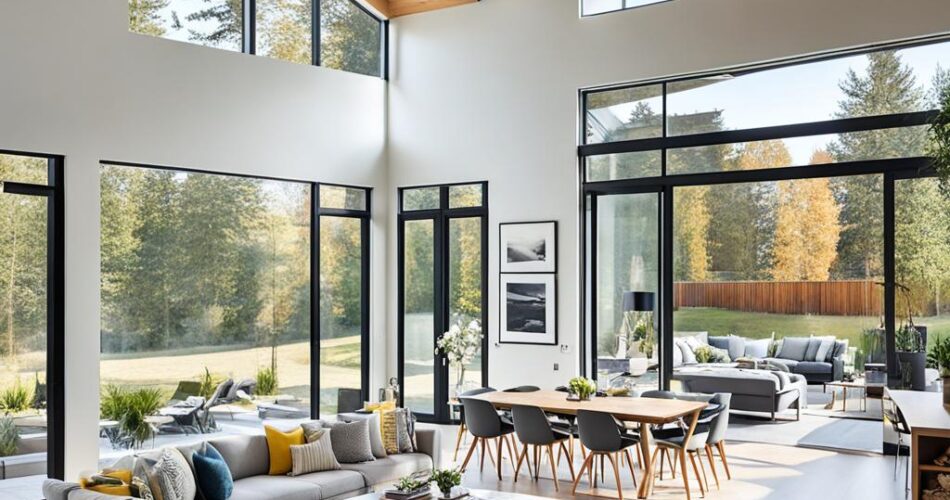In today’s world, contemporary house design embraces minimalist looks and practicality. These homes blend sleek lines, open floor plans, and sustainable materials. With focus on natural lighting and indoor-outdoor flow, modern architecture transcends traditional boundaries, offering fresh residential spaces.
At the core of contemporary house design lies effortless flow maximizing space. Open floor plans eliminate barriers, allowing spaciousness and organic movement. Large windows and glass walls flood interiors with natural lighting, connecting seamlessly with outdoors. Clean lines and geometric shapes lend sophistication, while minimalist interiors create serene, uncluttered ambiance.
Sustainable living is key to modern architecture. Homes integrate eco-friendly techniques and sustainable materials, treading lightly on environment. Energy-efficient features like solar panels and smart technology enhance responsible living, ensuring aesthetically pleasing and environmentally conscious contemporary house design.
Key Takeaways
- Contemporary house designs prioritize open floor plans and seamless indoor-outdoor living spaces.
- Natural lighting and sustainable materials are essential elements in modern residential architecture.
- Clean lines, geometric forms, and minimalist aesthetics define the contemporary style.
- Energy-efficient features and smart home technology are hallmarks of contemporary house design.
- Indoor-outdoor living spaces create a harmonious connection with the surrounding environment.
Embracing Contemporary Interior Design
Contemporary interior design embraces sleek lines, minimalist aesthetics, and functionality. These spaces feature clean geometric forms and a pared-down elegance. Natural materials like wood and stone with neutral colors create serenity. The minimalist approach extends to low-maintenance exteriors and energy-efficient elements.
Contributing to sustainable, eco-friendly contemporary homes, the design prioritizes simplicity.
Sleek Lines and Minimalist Aesthetic
The sleek lines and minimalist aesthetic embody functional aesthetics and modern architecture. Clean geometric forms characterize minimalist interiors. Natural materials and neutral palettes foster serene, low-maintenance living environments. Energy-efficient features contribute to sustainable living.
Mid-Century Furniture Revival
Contemporary design sees a resurgence of mid-century modern furniture pieces. These iconic designs with memorable forms complement minimalist spaces. Furniture from designers like Le Corbusier, Charles, and Ray Eames adds retro flair while maintaining sleek sophistication.
Bold and Dramatic Kitchen Designs
Contemporary kitchens embrace bold, dramatic elements with eye-catching details and striking palettes. Black kitchens create luxury and drama. Large windows and skylights maximize natural light, blending seamlessly with indoor-outdoor living prevalent in contemporary architecture.
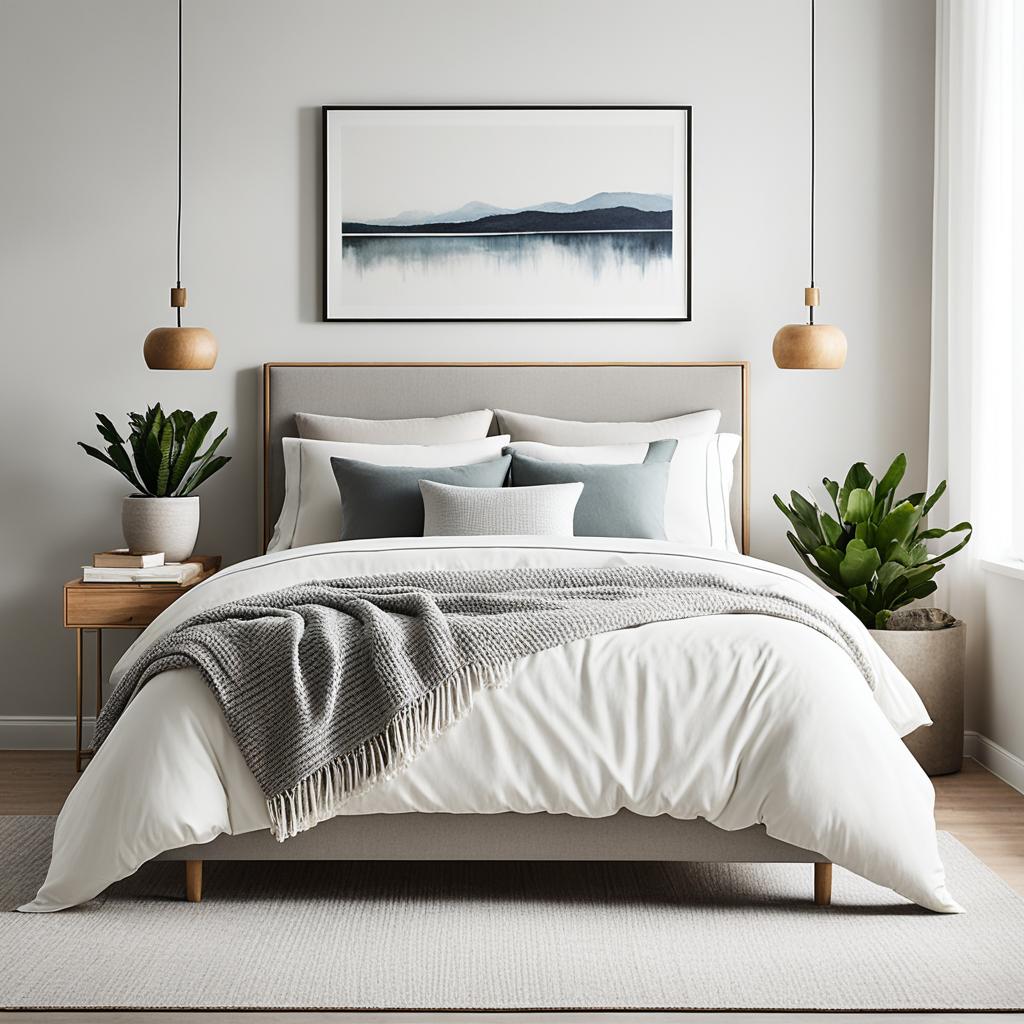
Curated Art Vignettes
Contemporary interiors feature curated art vignettes with carefully selected pieces. These add depth and personality to spaces. Vignettes may include contemporary art, sculptures, or functional objects elevated to art status. Curation creates refinement and allows homeowners individual style expression.
Harmonizing Contemporary Architecture with Nature
Contemporary architecture blends modern home design with the great outdoors. This is achieved through thoughtful integration of natural materials like wood, stone, and rammed earth. These organic elements create a cohesive connection with the landscape while contributing to sustainability.
A hallmark of cutting-edge home design is merging indoor-outdoor living spaces. Expansive windows, sliding glass doors, and covered patios blur interior and exterior boundaries. These integrated spaces provide entertainment and relaxation while amplifying spaciousness and natural light.
Modern architectural styles foster a sense of openness and connection with nature.
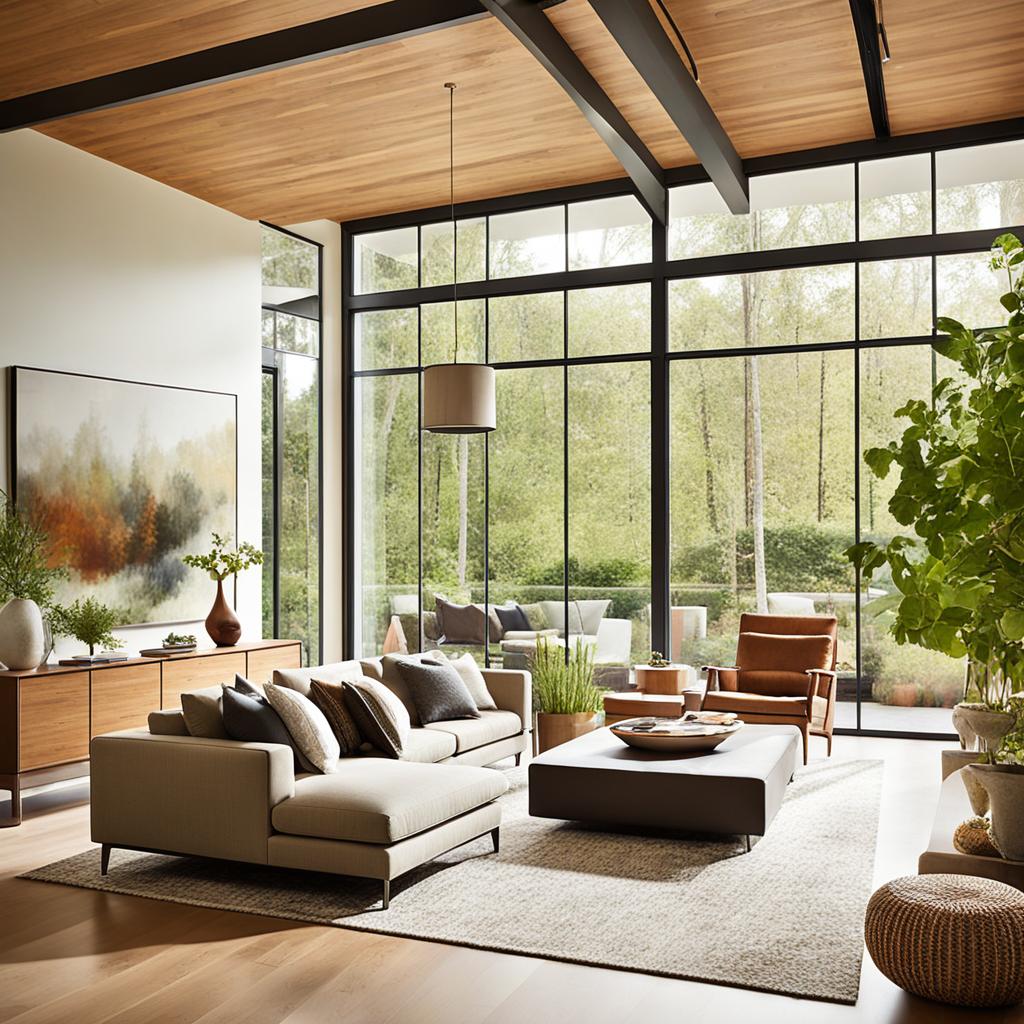
Sustainable and Eco-Friendly Homes
Sustainability and eco-friendliness are priorities in innovative housing concepts. Homes are designed for energy efficiency with solar panels, energy-efficient appliances, and insulation minimizing consumption. Sustainable building materials like reclaimed wood and recycled products reduce environmental impact.
Water conservation techniques like rainwater harvesting and greywater recycling contribute to sustainability. Contemporary architecture harmoniously combines luxury and environmental consciousness.
Integration of Natural Materials
Natural materials like wood, stone, and rammed earth in contemporary architecture create a warm, inviting atmosphere while preserving outdoor connections. These organic elements add texture and depth to minimalist interior aesthetics while contributing to sustainability.
The blend of glass, wood, and metal in open-concept floor plans fosters balance and tranquility. This harmonious combination of contemporary design and natural beauty celebrates the great outdoors’ beauty.
Indoor-Outdoor Living Spaces
A defining characteristic of luxury residential design is seamlessly integrating indoor and outdoor living areas. Large sliding glass doors, expansive windows, and covered patios blend interior and exterior spaces, creating openness and nature connections.
These open-concept layouts expand living areas and encourage embracing the outdoors’ beauty. Strategically integrated comfortable seating areas maximize scenic view enjoyment while offering relaxation and socializing spaces immersed in nature’s splendor.
Contemporary House Design Principles
Contemporary house designs blend minimalist looks, practicality, and sustainable home design. These trends focus on open living spaces, indoor-outdoor connections, and natural elements.
The designs create an inviting, eco-friendly environment.
Open Floor Plans and Flexible Spaces
Contemporary house design prioritizes open floor plans and flexible spaces. Open-concept layouts remove barriers between living areas, fostering flow and spaciousness.
Multipurpose rooms and movable partitions adapt spaces to changing needs. This contributes to modern homes’ functionality and versatility.
Large Windows and Natural Light
Natural light integration is key in contemporary designs. Large windows, skylights, and glass walls flood interiors with abundant natural light.
Strategic window placement and light-reflecting materials maximize natural light. This reduces reliance on artificial lighting, promoting energy efficiency.
The emphasis on natural light enhances aesthetic appeal, openness, and harmony with nature.

Geometric Forms and Clean Lines
Clean lines and geometric shapes define contemporary house design. These homes often feature sharp angles, rectangular forms, and flat or low-pitched roofs.
This creates a bold, modern silhouette. Clean lines and geometric forms extend to interior design with minimalist furniture pieces.
The emphasis on simplicity and precision contributes to visual appeal, functionality, and efficiency.
Contemporary designs prioritize low-maintenance, eco-friendly, and urban living spaces. These architectural trends cater to modern lifestyles, offering versatile, sustainable living environments.
The designs harmonize form and function with the natural world.
Innovative Materials and Unconventional Shapes
Contemporary house designs redefine architectural norms. They incorporate innovative materials and unconventional shapes that push boundaries. These homes feature striking material combinations like metal, concrete, and wood. They create visual contrasts and captivating textures.
Asymmetrical facades and curved walls add dynamism and intrigue. One sustainable trend is using fiber-cement siding. It’s a durable, cost-effective, and low-maintenance alternative to wood siding. This eco-friendly material enhances longevity and aligns with sustainable principles.

Contemporary house exteriors showcase contrasting materials, flat or low-pitched roofs, and industrial accents. This bold fusion creates a unique, visually striking aesthetic, unlike traditional styles.
Contemporary architecture typically combines both traditional and modern design features, resulting in a harmonious blend that seamlessly integrates innovative materials and unconventional shapes.
Coastal contemporary homes incorporate metal roofs and open-air living spaces. Urban dwellings embrace industrial aesthetics through seamless wood, glass, and metal integration. Modern furnishings and spacious layouts define this architectural movement.
| Material | Characteristics | Applications |
|---|---|---|
| Wood Planks | Natural, warm, versatile | Siding, interior accents |
| Stucco | Durable, textured, low-maintenance | Exterior facades, privacy walls |
| Fiber-Cement Siding | Sustainable, weather-resistant, cost-effective | Exterior cladding, siding |
| Metal Roofs | Sleek, modern, durable | Roofing systems, accents |
| Concrete | Robust, versatile, industrial aesthetic | Structural elements, flooring, accents |
Innovative materials and unconventional shapes distinguish contemporary homes from traditional styles. They reflect this architectural movement’s forward-thinking and experimental nature. By pushing design boundaries, contemporary house designs offer a fresh living space perspective, blending functionality, sustainability, and artistic expression.
Blending Contemporary Style with Traditional Elements
Contemporary house design blends modern and traditional elements seamlessly. This fusion adds character and warmth to clean, geometric shapes. Vintage pieces are integrated into contemporary settings gracefully.
Traditional architectural features like exposed beams or stone fireplaces are incorporated into modern designs. This blending creates depth and familiarity within contemporary architecture.
Juxtaposition of Old and New
The juxtaposition of old and new is key. Natural lighting strategies and contemporary exterior design combine with traditional architectural details. This fusion results in harmony.
Clean lines of modern furniture balance with vintage accents. This creates visually striking, personalized living spaces.
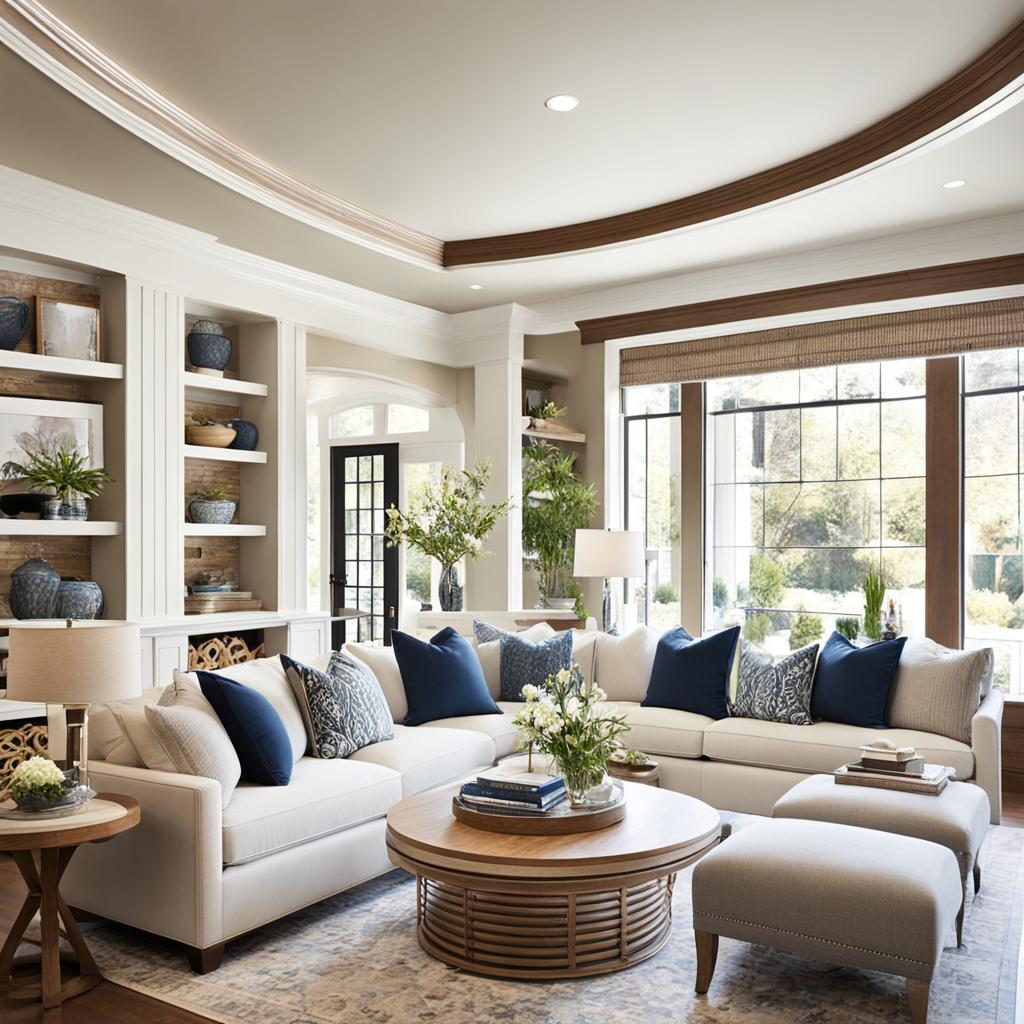
Combining natural stone, wood, glass, and metal achieves balance. Mixing furniture styles ensures a balanced room look. Warm traditional tones and vibrant modern colors create timeless designs.
Transitional and Eclectic Designs
Transitional and eclectic designs merge various movements’ elements. They reflect homeowners’ individual tastes and preferences. Transitional designs combine contemporary and traditional for warmth with modern twists.
Eclectic designs embrace diverse styles, textures, and low-maintenance materials daringly. They create visually striking, one-of-a-kind living environments.
| Traditional Design | Modern Design |
|---|---|
| Classic furnishings and ornate details | Clean lines and minimalism |
| Warm, muted color palettes | Bold, vibrant colors |
| Floral prints and damask patterns | Geometric patterns and modern art |
Balancing traditional and modern is key to successful mixing. Indoor-outdoor living concepts play a vital role in this fusion. Incorporating energy-efficient features and innovative concepts enhances the contemporary-traditional blend, creating unique living spaces.
Incorporating Sustainable and Energy-Efficient Features
Modern house designs lead sustainable living. Custom builders prioritize eco-friendly features. They reduce environmental impact and save costs.
Solar Panels and Renewable Energy
Top sustainable feature: solar panels. They reduce reliance on non-renewable energy. Ultra-efficient homes combine energy-saving techniques with solar panels.
Eco-Friendly Building Materials
Contemporary designs use eco-friendly materials. Examples: recycled wood, bamboo, cork. They reduce construction’s environmental impact. Green roofs and living walls add sustainability.
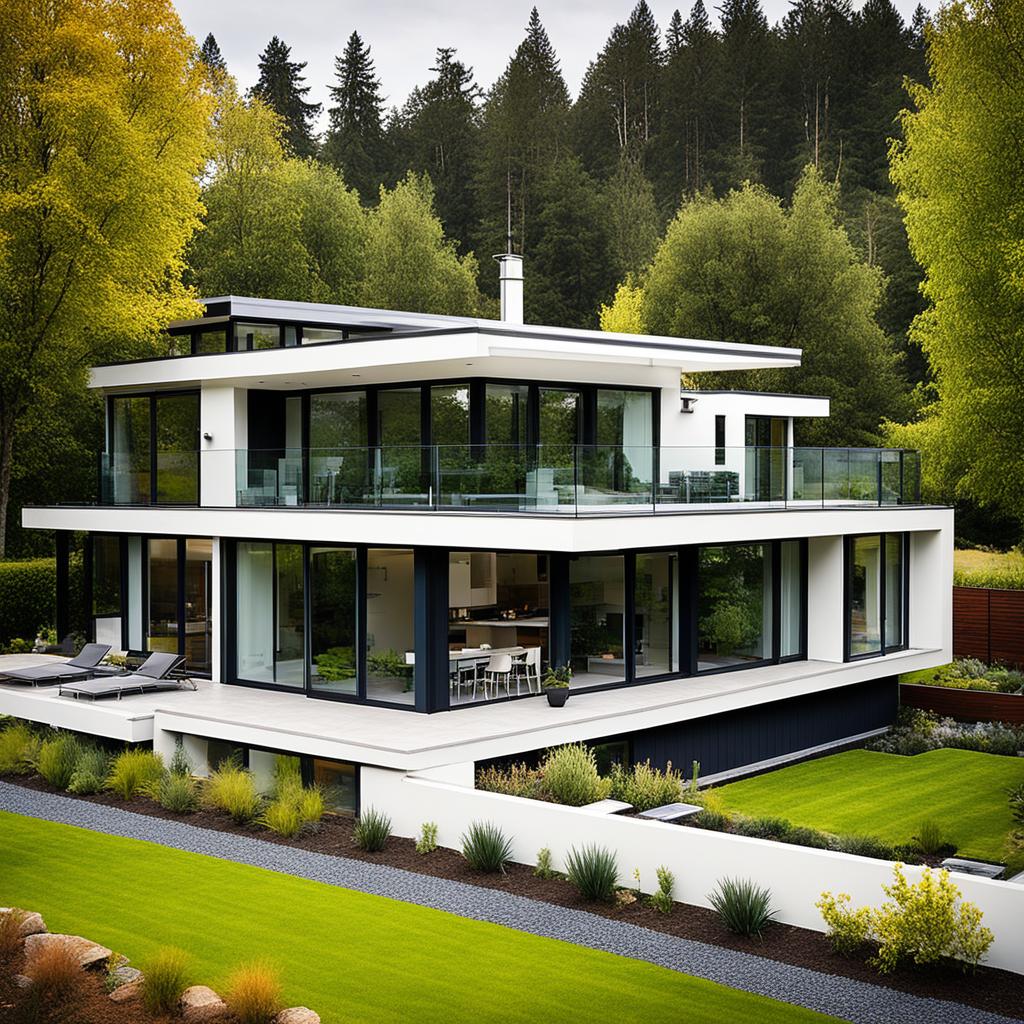
Natural Light Optimization
Optimizing natural light is key. Homes feature large windows and skylights. Strategic openings allow light penetration. Light reflecting materials distribute natural light.
Other sustainable, energy-efficient features:
- Advanced framing reduces lumber, improves insulation
- Cool roofs reflect heat in hot weather
- Passive solar design leverages climate conditions
- Proper insulation reduces heating/cooling costs
- Energy Star appliances and LED lighting
- Integrated insulation, HVAC, geothermal, air sealing
Contemporary designs reduce environmental impact. They provide comfortable, cost-effective living for homeowners.
Contemporary Outdoor Living Spaces
Contemporary home designs seamlessly blend interiors and exteriors. Large glass doors and covered patios create a harmonious transition. These open living spaces feel relaxed and natural.
The hallmark is effortless indoor-outdoor integration. Enjoy entertaining or relaxing in a cohesive environment. Sleek indoor finishes flow to functional outdoor spaces.
Modern furnishings, fire pits, and pergolas create an inviting ambiance for embracing this lifestyle.
Seamless Indoor-Outdoor Flow
Homeowners appreciate the convenience of living areas that flow seamlessly between indoors and out. This approach exudes openness and connection with nature.
Modern Landscaping and Hardscaping
Landscaping complements the minimalist aesthetic with clean lines, geometric shapes, and low-maintenance plantings. Hardscaping features like concrete paths and water features enhance curb appeal.
From Plan 930-509 with a large patio to Plan 1066-110 with outdoor living spaces, these designs prioritize stylish living areas integrated with nature.
Plan 1042-19 exemplifies indoor-outdoor living with a seamless flow between the covered porch and great room.
| Plan Number | Outdoor Living Features |
|---|---|
| Plan 930-509 | Large patio for indoor-outdoor living |
| Plan 23-2676 | Front and back porches for easy outdoor living |
| Plan 1066-110 | Plenty of outdoor living spaces |
| Plan 1066-100 | Multiple outdoor living areas, including a rooftop deck |
| Plan 1066-106 | Versatile living spaces and a rear grilling deck |
| Plan 1042-19 | Seamless flow between covered porch and great room |
With contemporary finishes, industrial elements, and stylish kitchens or bathrooms, these outdoor spaces embody modern living. They blend functional custom cabinetry with nature.
Smart Home Technology and Automation
Contemporary house designs integrate smart home technology. This offers homeowners convenience, energy efficiency, and security. Innovative architecture seamlessly incorporates natural lighting techniques. Modern homes embrace cutting-edge technologies for sustainable living.
Integration of Smart Devices
Smart home automation allows seamless device integration. Thermostats, lighting, security systems, and appliances interconnect. These devices are remotely controlled through apps. This convenience simplifies routines and saves energy.
Energy-Efficient Home Systems
Contemporary designs prioritize energy efficiency. High-performance HVAC, tankless water heaters, and eco-friendly appliances reduce environmental impact. Passive strategies like optimized ventilation and thermal mass regulation save costs.
Clean lines and simplicity through solar panels and energy-efficient lighting reflect sustainable living trends. Cost savings drive the integration of smart home technologies.
Urban infill housing developments blend indoor-outdoor flow with innovative architecture. Homeowners seek personalized, adaptable spaces catering to lifestyles. Accessibility, inclusivity, and future-proofing through flexible wiring are priorities.
| Smart Home Feature | Energy Savings | Convenience | Security |
|---|---|---|---|
| Smart Thermostat | Up to 23% on heating and cooling costs | Remote temperature control | – |
| Smart Lighting | Up to 30% on lighting costs | Voice control, automated scheduling | – |
| Smart Security System | – | Remote monitoring, automated alerts | Motion detection, video surveillance |
As smart home technology demand rises, contemporary house designs embrace these innovations. Homeowners enjoy modern aesthetics, sustainable features, and cutting-edge automation for an enhanced living experience.
Contemporary Home Office and Workspace Design
Remote work and home-based businesses drive contemporary home office design. These spaces feature minimalist furnishings, natural light, and seamless home integration. Home offices may have built-in storage, ergonomic seating, and productivity-boosting technology.
Out of 67 contemporary home office ideas, decor, color palettes, furniture, layouts, and functionality are highlighted. Design firms like Leanne Ford Interiors showcase modern, stylish setups.
Popular trends include pale wood, glass desks, warm gray, cream textiles, and terracotta walls. Elements like floor-to-ceiling drapes, open shelving, seating areas optimize functionality and appeal.
60% integrate natural materials like wood or rattan, blending modern and traditional. 40% feature glossy white lacquered cabinets for spaciousness. 20% mix modern and antique pieces.
Color schemes range from soft pastels to bold shades, enhancing ambiance and productivity. Lighting, rugs, decor, and storage define the modern, stylish look.
The article features various designers and architects, like Jennifer Post, Lee F. Mindel, Peter L. Shelton, Charles Gwathmey, Stephen Harvey, Emily Summers, Steven Gambrel, and many others. Different materials and furniture are highlighted, such as sucupira-wood desk, Hans Wegner chairs, Arne Jacobsen pendant light, Orrefors bowls, aluminum shelving by Rakks, vintage brass-and-leather accents, acrylic desk by Alexandra von Furstenberg, Eames desk chair by Herman Miller, Italian neoclassical secretary, Sultan Moroccan rug, and Red Tent Kilim, among others.
Fresh flowers (13%) add liveliness. Colorful artwork (33%) invigorates windowless areas. Custom steel-frame windows (26%) promote natural light and inspiration.
| Design Element | Percentage |
|---|---|
| Bold paint colors | 13% |
| Divided workspace into functional sections | 20% |
| Blending soothing and productive elements | 10% |
| Statement fireplace | 7% |
| Soft and gentle design elements | 7% |
| Sheds or garages as home office spaces | 7% |
| Jib doors for privacy | 7% |
Many homes incorporate flexible, convertible workspaces for evolving needs. Innovative techniques create energy-efficient, low-maintenance buildings blending contemporary landscaping with functional workspaces.
Personalized and Customized Contemporary Spaces
Contemporary house design prioritizes personalization. Homeowners blend minimalist interior decor with individual flair.
Furniture and decor reflect personalities. Bold artwork adds character to minimalist settings.
Unique textiles provide pops of color and texture, creating an inviting ambiance.
Expressive Furniture and Decor
Contemporary interiors embrace clean aesthetics. Homeowners infuse living spaces with expressive furniture.
Sculptural sofas and statement lighting fixtures add warmth. Patterned rugs and vibrant pillows offer coziness.
Unique Architectural Features
Contemporary homes feature innovative layouts. Floating staircases and cantilevered elements create drama.
Unconventional floor plans challenge traditional notions. These designs reflect a forward-thinking approach.
Built-in shelving and statement fireplaces enhance individuality. Customizations cater to homeowners’ specific needs.
The customization process balances functionality and affordability. Homeowners personalize house plans online.
Costs range from minor ($100-$700) to major changes ($1,500+).
Customization examples: reversing plans, redesigning rooms, changing exteriors, extending rooms, adding/removing rooms.
| House Plan | Square Footage | Bedrooms | Bathrooms |
|---|---|---|---|
| Truoba 320 | 2354 sq. ft. | 3 | 2.5 |
| Truoba Mini 419 | 1170 sq. ft. | 2 | 2 |
| Truoba Mini 220 | 570 sq. ft. | 1 | 1 |
Customized home designs cater to modern aesthetics. They accommodate smart home automation and energy-efficient design.
Customers receive 3D images and professional consultations. This ensures visions are realized.
Conclusion
Contemporary house design blends modern looks, sustainable practices, and innovative tech. These energy-efficient homes prioritize open, flexible living spaces. They seamlessly connect with nature through strategic natural light and ventilation.
Eco-friendly materials, smart home automation, and minimalist style offer visually striking, functional environments. They contribute to a more sustainable future.
As trends evolve, contemporary design will adapt and push boundaries. But simplicity, functionality, and harmony with nature remain core principles. These ensure comfortable, eco-friendly living experiences.
Contemporary homes integrate seamless indoor-outdoor connections through natural light and ventilation. This creates openness and tranquility. Renewable materials like wood, stone, and metal add warmth and texture.
As more homeowners embrace this trend, contemporary design will shape sustainable living’s future.
